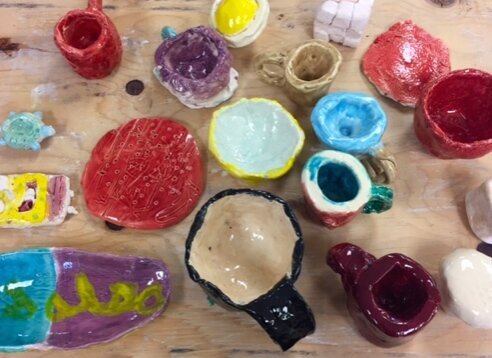Bob Reeker: Capstone Projects and Clay
“Capstone project” is one of the latest buzz terms in education. It is often a research-based experience resulting in demonstrating what is discovered during the research, and it can take most any form of delivery (http://edglossary.org/capstone-project/).
Introducing the Idea to Students
Although my students are not doing a formal “capstone” project, I shared the term and affirmed that this sculpture project will demonstrate 1) what has been learned about sculpture and clay during your elementary experience and 2) a personal voice --- create something that speaks of you as an artist/creator.
Students explored visuals, both in the classroom and on-line. This allowed for a saturation experience as students discovered many ways ceramics can be a vehicle for expression. Then, as part of the creative process, students envisioned possible solutions for their own clay experience. I normally ask for several sketches from students, but due to time constraints this year, students were invited to create at least 2 sketches.
Applying Previous Knowledge
From those sketches and discovering the “a-ha” solution, students utilize previous knowledge about hand-building (pinch, coil, slab) and joining clay (score, slip, join) to create their capstone piece. Following a bisque firing, students then used glaze to complete the piece.
Displaying the Work
Work was displayed in the hallway along with information cards identifying name, grade, room number, title, and media. In addition, my district has implemented electronic portfolios for K-12 using Google Sites. Students use iPads to photograph the work and add titles. There are opportunities to use the portfolio to reflect and write about both the progress of the work as well as a final summary of the learning during the unit.
Teacher Reflection
Each year, I tweak the process a bit. This year, using the terminology of capstone is new. However, in the end, I want my students to have the autonomy to think, reflect, and utilize the many skills developed over six years in the elementary art room.
I find using this final sculpture experience with 5th graders help for stronger focus as students prepare to move to 6th grade. It allows for students to reflect on the previous years of sculpture experience and then allow for personal voice & choice as a culminating final art expression as they leave elementary school.
THANK YOU to guest blogger Bob Reeker. Bob is an amazing art educator and all around great human being. We appreciate all you do for art education.
Bob Reeker will be teaching art and creative computing this fall at Elliott Elementary in Lincoln, NE. He also teaches elementary art methods at Nebraska Wesleyan University as an adjunct. He is the NAEA Western Region Vice President-Elect and is co-chair of Nebraska's fall conference in Lincoln this fall.
Originally posted in May 2017




